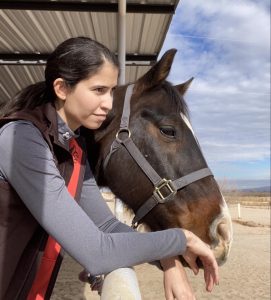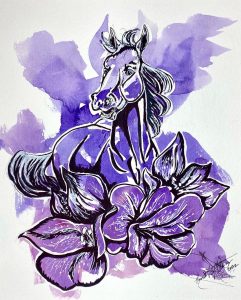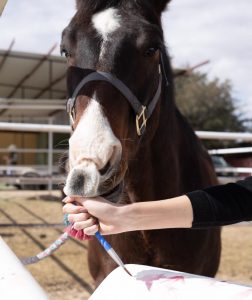Pámela Vigo Sánchez
Pámela Vigo Sánchez is a contemporary equine artist based out of El Paso, Texas. Pámela has a bachelor in art degree from the University of Texas at El Paso (UTEP), and has been active in the local El Paso artist community since graduation. In addition to being an artist, Pámela is also an avid equestrian. This equine artist is and has almost always been around horses, whether drawing them onto paper or saddling up her own horse, an Appendix gelding named Indy. She uses this stable life experience to inspire her work and artistic practices, scheduling time to draw and create around riding sessions and caring for her horse.
Supplementing her solo work responding to the modern societal climate, including all social issues that also affect the equine community, she creates truly one of a kind work with her equine assistant. Indy paints the unique colorful backgrounds to her line work, adding an abstract touch to a subjective body of work. He nuzzles, licks, and sometimes nips at Pámela’s hand holding the paintbrush to achieve the watercolor washes and strokes that serves as the backdrop to the bold line art. The duo share their partnership outside of the riding arena into the gallery setting through their work, allowing the wider public to view what is normally a private affair between horse and rider.
While their gallery work is created to show off their teamwork and stable life, the unconventional artist pair finds their passion in creating portraits of animals that emphasize on the animal’s personality. Pámela and Indy tackle every animal under the sun, from the now extinct dinosaurs to a family pet.
Indy Painting
Photo credit to Strange Studios Photo
Q&A
- What influenced you to become an artist?
I had always liked drawing. It was not until I had seen Spirit: Stallion of the Cimarron that I wanted to become a more serious artist. Drawing Spirit correctly was my ultimate goal as a kid, and it temporarily halted my desire to progress my drawing skills as I felt like I wasn’t getting to that goal quickly enough for my impatient young mind. A combination of that failure feeling and being bullied in school for liking horses that kept my drawings at bay until college. It took my previous horse, Dan, passing away to rekindle that need to create. I picked up the paper and pencil again to keep Dan’s spirit alive, and of course finally learn to draw Spirit right. The final step into becoming a full fledged artist was to switch from a pre law degree to art, and in the summer of 2015 that’s precisely what I did.
- What inspires you? What do you do when you get into a creative block?
What inspires me depends on what is going on in my life at the time, or what I am interested in. Of course my daily experiences with my horse influence my work quite a bit, though. The child dream of wanting to draw my favorite equine character is still at the forefront of my inspirations, just has shifted to what I now have access to as an adult horse girl. Spirit switched to my friends’ horses, experimenting with techniques and drawing styles on them, and eventually creating vast collections backed by research on horses in culture.
When I do find myself in an art block, I go back to why I started drawing in the first place. I doodle little sketches of some of my childhood favorites, or tap into old reference photos I have of horses. Sometimes I would try a new material to switch things up and focus on playing around with it to restart the creative juices. In a worse case scenario, a “vacation” to clear the mind works. That “vacation” may look like an international flight or spending long days at the barn, of course with a sketchbook on hand to jot anything down that ignites a spark.
- How would you describe your style? When did you first know you had a personal style?
My style is a careful balance of monochromatic figurative work set upon a backdrop of colorful washes, taking care that one element does not overpower the other. I have dubbed it the “Indoodle”, a word I made up that combines “Indy” and “doodle” to properly label the joint style. The final piece’s appearance is one way to understand our style, but the process that goes into it is another signature trait of my style. The stark white sheets of paper are stained with dirt, green alfalfa stains, and sometimes a yellow brown from Indy’s nose and mouth. On occasion the artwork is warped from how I hold it up to Indy, or him biting and grabbing onto it. Our style is a culmination of the framed art to the lengthy process before the art was placed in a frame. It’s the expected sunshine and rainbows of the stable life with the messy reality it actually is.
It wasn’t until after I had completed a college assignment when I noticed my personal style developed. It took some experimentation and trial and error to figure out an effective system and material list for my artistic process. Though before this, my style was known for using the horse image in everything I created. I was the horse girl of UTEP DoArt, and was almost expected to slip in a horse or reference to a horse in my assignments one way or another. Naturally I kept up with the expectation and it was only slightly surprising when I brought Indy into the process. Now our combined mark making techniques are easily recognized regardless of where our art is on view.
- What would you like the viewer to take away from your art?
I would like viewers of our art to visually see a horse and his rider working together. It tells a story of how we made each piece, possibly even what kind of day we had while creating it. The subject matter of our artwork is just as important. I always strive to capture the personality of my subject, that moment in which the photo was taken and the feelings of those who exist with the subject. The colors can set the mood, the drawing will determine what is happening on the page and possibly predict what would happen next if it were animated. All in all, our art should tell many stories and give the audience enough information to create their own.
- How has it been to work with artists whose work is different from yours?
The biggest takeaway from working with artists with different styles has been how we all create our work differently and the requirements each of our works needed to be presented. Joanna’s Instagram live videos show how she creates paintings almost instantly in a flip of a cup and can use the drippings to create even more just from that one spontaneous moment. Gia and I share the lengthy process of determining what figures she wants to paint and juggling other demanding art needs at the same time. Lastly, my work requires a 40 minute drive to the barn Indy is boarded at for him to paint and the framing for display, so I was unable to make pieces last minute and had to make a deadline earlier.
Despite being visually vastly different, the three of us shared one thing in common: we all use color as a dominating feature in our work. All of our pieces flow into each other. Joanna’s abstract paintings almost literally flow into Gia’s grid like line faces, and then break again into abstraction with Indy’s watercolor washes and my line horses. It feels like each of our pieces are steps into the next one. The work all compliments each other.
- What are your future plans as an artist?
My future plans would continue to create large collections of art such as the set created for this exhibition. I have several of these large scale projects in various stages of planning and hope to formally start them this year. I hope with adding more complete collections available, my portfolio would be strengthened for gallery representation. In addition to creating more unified collections of work, I hope to continue to be able to showcase my work around El Paso, abroad, and in equestrian spaces. The end goal is to have my own home studio with enough land to house Indy, so we can create art and ride in our own little ranch.
Regardless of my plans on paper, I know I will continue to make art, have Indy assist me as long as he still wants to, and spreading our Indoodles far and wide.


